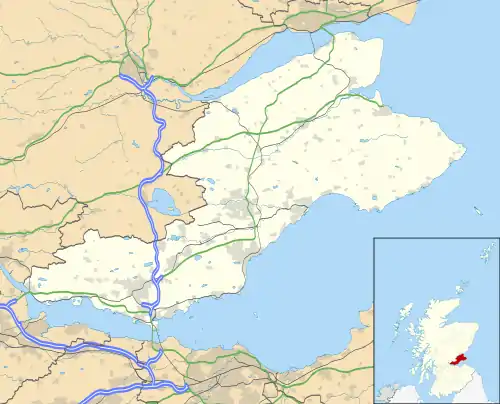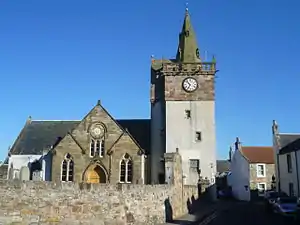Pittenweem
| |
|---|---|
 Pittenweem | |
 Pittenweem Location within Fife | |
| Population | 1,450 (mid-2020 est.)[1] |
| OS grid reference | NO5402 |
| Council area | |
| Lieutenancy area | |
| Country | Scotland |
| Sovereign state | United Kingdom |
| Post town | ANSTRUTHER |
| Postcode district | KY10 |
| Dialling code | 01333 |
| Police | Scotland |
| Fire | Scottish |
| Ambulance | Scottish |
| UK Parliament | |
| Scottish Parliament | |
Pittenweem (/ˌpɪtənˈwiːm/ ⓘ) is a fishing village and civil parish in Fife, on the east coast of Scotland. At the 2001 census, it had a population of 1,747.
Etymology
The name derives from Pictish and Scottish Gaelic. "Pit-" represents Pictish pett 'place, portion of land', and "-enweem" is Gaelic na h-Uaimh, 'of the Caves' in Gaelic, so "The Place of the Caves", named after St Fillan's cave.[2][3] The name is rendered Baile na h-Uaimh in modern Gaelic, with baile, 'town, settlement', substituted for the Pictish prefix.
History
The settlement has existed as a fishing village since early medieval times. The oldest structure, St. Fillan's Cave, dates from the 7th century. An Augustinian priory moved here from the Isle of May in the 13th century, but there was already a church at that time. Pittenweem Parish Church (which is attached to the local tolbooth) has a Norman doorway dating to before 1200. The gatehouse to the east is 15th century. The priory dormitory and refectory was remodelled post-Reformation (1588) to give a new function as a manse. This building was later named the "Great House".[4]
Until 1975 Pittenweem was a royal burgh, having been awarded the status by King James V (1513–42) in 1541.[5]
Founded as a fishing village around a probably early Christian religious settlement, it grew along the shoreline from the west where the sheltered beaches were safe places for fishermen to draw their boats up out of the water. Later a breakwater was built, extending out from one of the rocky skerries that jut out south-west into the Firth of Forth like fingers. This allowed boats to rest at anchor rather than being beached, enabling larger vessels to use the port. A new breakwater further to the east was developed over the years into a deep, safe harbour.[6]

In 1779 John Paul Jones (founder of the American Navy) anchored half-a-mile off Pittenweem in the USS Bonhomme Richard.[7]
There is a feudal Lordship and Barony of Pittenweem created by James VI for Frederick Stewart in 1609. It was held by the Earls of Kellie until it passed to Sir John Anstruther and then to the Bairds of Elie. The current Lord Baron is Claes Zangenberg.[8]
Industry
Pittenweem is currently the most active of the fishing ports in the East Neuk coast of Fife.[9] In the 18th century, Pittenweem had a series of coal mines on the coast between Pittenweem and St Monans.[10]
At one time the village was served by the Fife Coast Railway.[11]
Geography
The village sits astride a raised beach.[12]

Education
Pittenweem Primary School is a traditional village school with its own playing fields on the northern side of the older part of the village. It caters for children aged 4/5 to 11/12. Secondary education (up to ages 16, 17 or 18 depending on educational ambitions) is provided at Waid Academy in the neighbouring town of Anstruther. The nearest private educational institution is St Leonards School in St Andrews, or the High School of Dundee.[13]
Religion

In the Middle Ages, Pittenweem Priory was a small Augustinian monastery linked to that on the Isle of May and built over the ancient sacred cave associated with St Fillan. The cave, which is fitted out as a chapel, was rededicated as a place of worship by the Bishop of St. Andrews in 1935.[14][15]
Current denominations with churches include: Church of Scotland, Catholic, Episcopalian and Baptist. Other denominations have had churches or the equivalent, but these have been converted to other purposes. The Parish Church Hall, for example, was once "Pittenweem St. Fillan's".[16]
The late 17th to early 18th centuries saw a number of notorious witch-hunts by the local minister. Pittenweem Tolbooth was used as the jail for some of the Pittenweem witches. Five women were severely beaten and one was murdered by a lynch mob.[17]
Culture

In the late 1960s the local fishermen celebrated the re-opening of the re-designed harbour with a Gala Day, when the boats were dressed overall and people could take short trips on the boats. By the early 1980s, however, increasing regulation, higher fuel costs and a shrinking fleet were bringing this event to its knees. In its place in 1982 sprang up an Arts Festival,[18] which initially incorporated the Gala Day as its finale. The Arts Festival has moved on somewhat, however, becoming one of the best-loved art festivals in Scotland with an estimated 25,000 visitors in 2013.[19] Many artists have re-discovered the charms and the light of the area, which was always popular with itinerant and hobby artists, and have moved to the village, creating a vibrant artistic community.[20]
Pittenweem had the first newspaper in the area – the Pittenweem Register (1844–56).[21]
There is also a fairly well-known song, "Pittenweem Jo", written in 1960.[22]
Much of the 1997 film The Winter Guest was filmed in the village.[23]
Politics
The local Member of the UK Parliament (representing North East Fife) is Wendy Chamberlain of the Liberal Democrats.[24]
The local (representing Fife North East) Member of the Scottish Parliament (MSP) is Willie Rennie of the Scottish Liberal Democrats.[25]
From 1885 to 1983, Pittenweem was part of the East Fife Parliamentary constituency, its most famous MP being Prime Minister H. H. Asquith (Liberal) from 1886 to 1918.[26]
Sport
The local football team is Pittenweem Rovers AFC. The local rugby team is Waid Academy FPRFC.[27]
Bus services
Pittenweem is served by two main bus services operated by Stagecoach East Scotland. These are:[28]
- 95 from Leven to St Andrews via Anstruther and Crail[29]
- X60 from Edinburgh to St Andrews via Kirkcaldy, Leven and Anstruther[30]
Notable people
- John Douglas (1721–1807), Anglican Bishop of Salisbury[31]
- Sir Walter Watson Hughes (1803–1887), public benefactor, founder of the University of Adelaide, South Australia[32]
- Wallace Lindsay (Wallace Martin Lindsay) (1858–1937), classical scholar, Professor of Humanity at St Andrews University, 1899 to 1937[33]
- John Smith (1770–1816), clockmaker[34]
- Frederick Stewart, Lord Pittenweem (1591–1625), local aristocrat[35]
- Ian Stewart (1938–1985), musician[36]
In Popular Culture
British power metal band Gloryhammer have a song titled "Vorpal Laserblaster of Pittenweem" on their 2023 album "Return to the Kingdom of Fife".
Gallery
 West Shore, Pittenweem from the West Braes showing skerries in the foreground, the old harbour in the mid-ground and the new harbour in the background. The Isle of May (or May Island) is on the horizon.
West Shore, Pittenweem from the West Braes showing skerries in the foreground, the old harbour in the mid-ground and the new harbour in the background. The Isle of May (or May Island) is on the horizon. West Shore, Pittenweem from the West Braes
West Shore, Pittenweem from the West Braes Pittenweem swimming pool looking towards St Monans with the Lady's Tower, Elie, in the distance
Pittenweem swimming pool looking towards St Monans with the Lady's Tower, Elie, in the distance Pittenweem Harbour
Pittenweem Harbour
See also
References
- ↑ "Mid-2020 Population Estimates for Settlements and Localities in Scotland". National Records of Scotland. 31 March 2022. Retrieved 31 March 2022.
- ↑ "St Fillan's Cave". Gazetteer for Scotland. Retrieved 30 March 2023.
- ↑ "St Fillans Cave". Welcome to Fife. Retrieved 30 March 2023.
- ↑ Buildings of Scotland: Fife by John Gifford
- ↑ "Pittenweem Burgh". Vision of Britain. Retrieved 12 August 2022.
- ↑ "Pittenweem Breakwater". Codhead Bob. Retrieved 12 August 2022.
- ↑ Logan, W. H. (2020). A Pedlar's Pack of Ballads and Songs. Salzwasser-Verlag GmbH. p. 448. ISBN 978-3846050095.
- ↑ Morrow, Joseph (18 January 2016). "full-grant.jpg". Barony of Pittenweem.
- ↑ "Pittenweem". Undiscovered Scotland. 2016. Retrieved 13 August 2016.
- ↑ Martin, Colin. "The 18th century industrial landscape between St Monans and Pittenweem: a cartographic and archaeological study" (PDF). Tayside and Fife Archaeological Committee. Retrieved 12 August 2022.
- ↑ Historic Environment Scotland. "Pittenweem, Charles Street, Station (34251)". Canmore. Retrieved 12 August 2022.
- ↑ "St Monan's Geological Trail" (PDF). University of St Andrews. Retrieved 12 August 2022.
- ↑ "Corporation of The High School of Dundee, SC011522". Office of the Scottish Charity Regulator. Retrieved 12 August 2022.
- ↑ "St Fillan's Cave". BBC "Central and Fife". Retrieved 12 August 2022.
- ↑ Sharp, Mick, The Way and the Light, Aurum Press Ltd, 2000. ISBN 1-85410-722-4
- ↑ "Pittenweem St. Fillan's (now Parish Church Hall)". Scottish Churches. Retrieved 12 August 2022.
- ↑ Harrower-Grey, Annette (April 2009), "Walking with witches", Scotland Magazine, no. 44, p. 68, archived from the original on 2 February 2017, retrieved 24 January 2017
- ↑ Peebles, Cheryl (5 August 2016). "Pittenweem art festival will draw thousands to East Neuk of Fife". The Courier. Retrieved 13 August 2016.
- ↑ Peebles, Cheryl (31 July 2013). "Thousands expected at Pittenween Arts Festival". The Courier. Retrieved 13 August 2016.
- ↑ "Art Trail: Pittenweem Arts Festival". Open House Art. 2016. Retrieved 13 August 2016.
- ↑ "The Pittenweem Register – Local News, BMDs 1844-1856". Fife Family History Society. Retrieved 12 August 2022.
- ↑ Buchan, Norman, ed. (1962). 101 Scottish Songs. Collins. p. 88. ISBN 9780008136611.
- ↑ "A Winter's Tale". Herald Scotland. 20 December 1997. Retrieved 2 June 2023.
- ↑ "Election 2019: SNP's Stephen Gethins loses to Lib Dems in UK's narrowest marginal". BBC News. 13 December 2019. Archived from the original on 15 December 2019. Retrieved 29 April 2020.
- ↑ Davidson, Peter (7 May 2021). "Scottish Election 2021: Willie Rennie retains seat in North East Fife". Daily Record. Archived from the original on 11 September 2021. Retrieved 11 September 2021.
- ↑ "The General Election", The Times, 9 July 1886, p. 10; and "The Election", The Manchester Guardian, 9 July 1886, p. 8.
- ↑ "Waid Academy F.P. Sevens". Scottish Sevens. Retrieved 12 August 2022.
- ↑ Bus list
- ↑ Bus timetable
- ↑ Bus timetable
- ↑ "Douglas, John (1721–1807), bishop of Salisbury and writer". Oxford Dictionary of National Biography (online ed.). Oxford University Press. 2004. doi:10.1093/ref:odnb/7908. Retrieved 27 November 2020. (Subscription or UK public library membership required.)
- ↑ Serle, Percival (1949). "Hughes, Walter Watson". Dictionary of Australian Biography. Sydney: Angus & Robertson. Retrieved 17 February 2016.
- ↑ Matthew, H. C. G.; Harrison, B., eds. (23 September 2004). "The Oxford Dictionary of National Biography". Oxford Dictionary of National Biography (online ed.). Oxford University Press. pp. ref:odnb/34547. doi:10.1093/ref:odnb/34547. Retrieved 9 November 2019. (Subscription or UK public library membership required.)
- ↑ "Pedestal clock 1780 - 1800: John Smith of Pittenweem". Royal Trust Collection. Retrieved 12 August 2022.
- ↑ "Lordship and Barony of Pittenweem". Lordship & Barony of Pittenweem. Retrieved 12 August 2022.
- ↑ Ian Stewart, Scotland on Sunday, 16 April 2004


